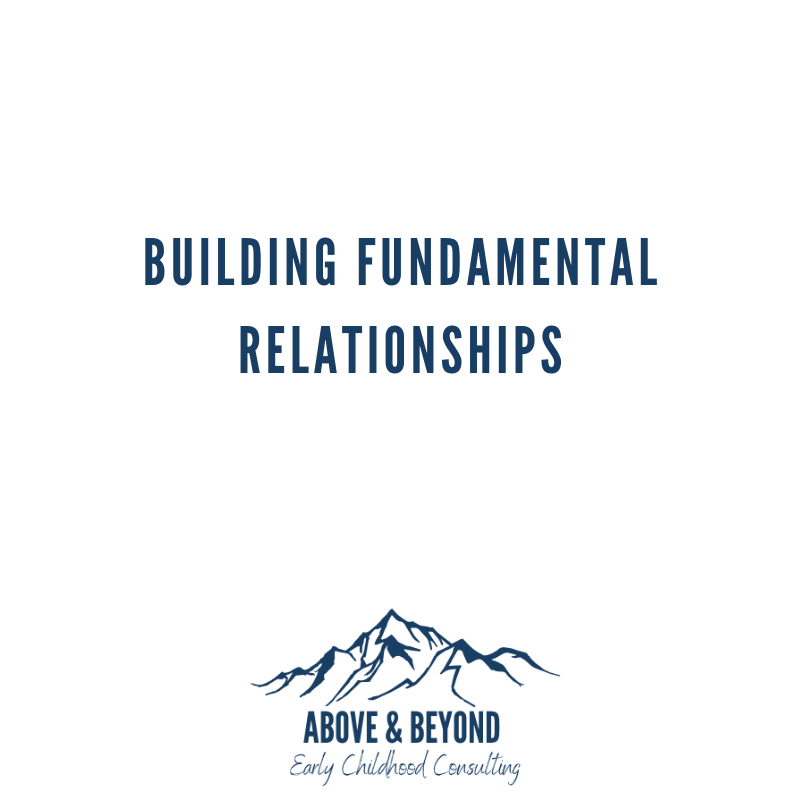Building fundamental relationships

Building fundamental relationships as an educator is at the core of our job role. Not only is it a vital part of the National Quality Standard (QA5 Relationships with children) QA6 (Collaborative partnerships with families and community) and the EYLF/MTOP, most importantly it should be an intrinsic feeling. An educator should want to establish relationships because they understand the joy that it will bring to themselves and the family they are welcoming into the centre/setting environment.
This time of the year is when we begin our journey with new families. As we know many families can be feeling emotions of stress and anxiety having to leave their child/children with people that are not family.
As educators, it is our role to make the families feel an authentic sense of belonging to the centre/setting environment. This starts at orientation. When new families entire the room, educators should always stop and say ‘hello’ not only to the family, but also the child. The family is observing if you welcoming of their child. They want to see that you will build a relationship and make them feel safe and secure when the family leaves.
Urie Brofenbrenner teaches us in the ecological systems theory about the different environments that are encountered and how it can affect the behaviour of a person. It is important to note as educators, we have a direct influence on the child’s environment in the school setting. It is important to reflect what type of environment you are setting for the child in regards to relationships.
When a child feels safe and secure, they will go and explore their environment and start to play. Their confidence begins to grow and they will feel a sense of belonging, which is a very important part of the Early Years Learning Framework.
The beginning of a school year can at times be hectic. There are new families, leaving their children and the environment can be chaotic for both educators and families. I remember visiting a centre/setting at the beginning of a school term and the ambience of the room was chaotic. Educators where run off their feet, new families were looking for an educator to drop of their child and children were crying left alone and feeling a sense of uncertainty.
The importance of collaborative relationships is to communicate to families the steps the centre/setting/setting has in place take to make the child feel welcome and have a smooth transition into the centre/setting environment.
Ways that this can ensure it is happening is to have educators review the principles and practices of the EYLF and discuss how they can put the principles into practice. Have educators write strategies under each point on how this can happen!
• 1. Secure, respectful and reciprocal relationships
• When children develop secure relationships with trustworthy adults, they feel more confident and able to learn.
• 2. Partnerships between early childhood educators and families
• When families and educators work together, they can enhance children’s wellbeing and learning achievement.
• 3. High expectations and equity
• When educators and families hold high, reasonable expectations for all children, all children are more likely to reach their learning potential.
• 4. Respect for diversity
• When the early childhood curriculum values and connects with the practices, values and beliefs of children’s cultures and communities, it motivates children to learn.
• 5. Ongoing learning and reflective practice
• When educators closely examine events and experiences from different perspectives and critically review their practices, curriculum quality, equity and children’s learning improve.
(EYLF PG 12-13)
DO…….
· Reflect on the centre/setting philosophy and if educators are aligning with the content
· Reflect on the current environment is it inviting and creating a sense of wonder for children to explore?
· Be mindful of children’s temperament and personalities, learn what they like/dislike, don’t just assume that they will want to join an activity straight away and call them over to join in
· Reflect on the staff roster. Is there availability to place more staff in the early morning to make drop off a smoother transition and answer any questions that families may have?
· Reflect on the way you are feeling with new families. Do you feel overwhelmed and unsure how to handle a child that cries and runs away when the family leave the centre/setting? Speak to the family and let them know what strategies are in place once they leave. Let them know they are welcome to call the centre/setting to see how the child is settling in or send them a photo or offer a phone call. This can make all the difference in the world.
· Have time to reassure families that transition takes time and how you are committing to building a relationship with their child so they feel safe and secure.
· Stay close to a child that is upset, but never force them to hug you or hold your hand if they don’t feel comfortable
· Do offer words of reassurance ‘I can see you are feeling upset’, I’m sitting right next to you for when you are ready to come and play’.
· Support each other. If an educator has been with a child who is distressed and crying for a period of time, offer support i.e go over and sit with the child so the other educator can have a break
· Offer support for families that are finding it hard to leave their child unsettled. Take them to the office or staff room for a chat and coffee or walk them to their car (if ratios allow) and give them an opportunity to tell you how they are feeling
· Refresh your understanding of the Code of Ethics to guide your interactions, especially in regards to ‘With families I will’
Don’t………
· Tell families they ‘had a good day’ if they didn’t. Be authentic in your answer, reassure families that smooth transitions will happen and these are the practices in place
· Take your frustrations out on the children. Use the three levels of critical reflection
1. React
2. Elaborate
3.Reconstruct (more information on this can be found at https://eprints.qut.edu.au/…/Critical_Reflection_-_Gowrie_A…)
· Make it personal (ie. ‘here comes that family again’)
· Assume that you know a child after one week. E.g. ‘Just leave them as they don’t like to do anything’. Take the time to build a relationship
· Talk about families in the staff room, rather collaborate on strategies that can make the family and child feel welcome
· Give up. Relationships take time, children need to feel secure in their environment and educators need to feel an intrinsic motivation to provide this
Over the next few weeks, reflect on the transition process that is happening at the centre/setting. Reflect if there are changes that can be made in the way you are communicating to families and children. Reflect if you are making the effort to collaborate with families on building fundamental relationships. Reflect on the language you are using during drop off/pick up. Reflect on the way the team is collaborating with each other and about families.
With this reflection and collaboration, you can ensure that you are providing the best transition for new families and know that you are making positive connections to building fundamental relationships.
References and further reading
https://eprints.qut.edu.au/…/Critical_Reflection_-_Gowrie_A…
https://raisingchildren.net.au/…/…/relationships-development
https://www.rch.org.au/…/TM_ISEIConf07_Nature_role_rships.p…
https://www.acecqa.gov.au/…/belonging_being_and_becoming_th…
